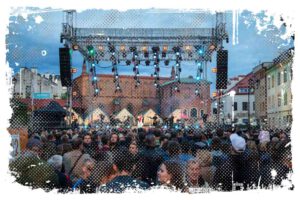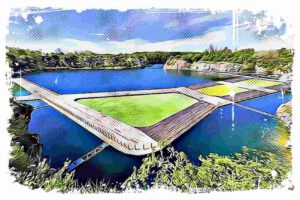In the historical heart of Kraków, there stands an imposing testament to Poland’s rich literary heritage, the Adam Mickiewicz Monument. Now, let me say this, it’s not just any monument. This grand bronze sculpture, dedicated to Adam Mickiewicz, the national poet of Poland, is a veritable symbol of cultural and patriotic significance.

I think, no visit to Kraków is complete without witnessing this magnificent piece of art crafted by the renowned artist and sculptor, Cyprian Godebski. I am convinced that this monument captures the spirit of Mickiewicz’s literary legacy in a profound way, inviting every visitor to immerse in the beauty of Poland’s poetic past.
Adam Mickiewicz Monument Creation

If you’re intrigued by the backstory of iconic landmarks, you need to know about the history of this monument’s erection. The idea to build a monument to the national bard in Kraków came into being in the late 1860s. Now, here’s the interesting part, this idea was born among the academic youth who were also thinking about transferring Adam Mickiewicz’s ashes from Paris to Wawel. I can tell you, even though Adam Mickiewicz himself had never been to Kraków, the idea ignited a wave of national and patriotic spirit in the society, as described by Jan Adamczewski.
However, it was only in 1879 that a special committee came into existence, and a competition was announced in 1881 for the design of the monument. The terms? A Renaissance-style monument made of bronze and granite, a concept that stirred many debates in the artistic community. What’s more, the cost of construction was capped at 100,000 Rhenish zlotys. Even the prize was set at 1000 francs, but there was a twist – the award of the project didn’t mean automatic selection for implementation.
↳ Make sure to read my guide to the most amazing places to stay in Kraków:
How to Find Best Place to Stay in Krakow Old Town – Your Guide

Out of the 27 designs submitted in the competition, Tomasz Dykas’ design took the prize. But the people of Kraków were less than thrilled with his vision of erecting the monument at Franciszkański Square. I believe the voices of Bolesław Prus and Władysław Mickiewicz, the poet’s son, were significant in this context. They felt the design failed to capture the essence of Mickiewicz. As Prus commented,

„In Kraków, some would like to have a great monument, others – cheap!”
An Iconic Landmark Against Odds
So, if you’re wandering around Kraków, stop by this iconic landmark. It stands as a symbol of Poland’s cultural depth, a tribute to a great poet, and a testament to a community’s love for art and heritage. I know, the journey of its creation wasn’t straightforward, but it was worth it. Today, the Adam Mickiewicz Monument in Kraków remains an essential part of the city’s charm, making it a must-visit for everyone.

Let me take you back to 1883, when a competition for a monument was announced for the second time. Picture this, it’s March 1, 1885, and the new jury is meeting at the Sukiennice. They’re not alone, they’ve got guests from cities like Vienna, Lviv and Paris. Out of the 31 works thrown into the competition, it was the design by Dykas that stole the show. However, just because it won didn’t mean it was destined to be brought to life.
The Unexpected Choice
Here’s a twist, Jan Matejko also had a design in the competition. Now, they didn’t ask him to make his design in plaster, even though his idea didn’t really win the crowd over. One fellow, Bolesław Prus, wasn’t shy about his opinion. He said, and I quote,
„Matejko’s last sketch has no value. A naked madman is sitting in an armchair, in front of him a winged madman shows him an eagle… and next to them some woman is combing her hair… We would be ridiculous if we built such a freak for Mickiewicz.„
Now, the Committee for the Construction of the Monument to Adam Mickiewicz wasn’t broke. Their bank account was fat with 94,000 Rhenish zlotys donated by the public. But, guess what? They still didn’t have a design for the monument that the public could agree on. Let me say, back in 1886 a third competition – a closed one – was announced.
The results were declared two years later, on January 16, 1888, and three works were chosen for recognition. The first prize was bagged by Cyprian Godebski, the second by Teodor Rygier, and the third by Walery Gadomski. Interestingly, another project by Teodor Rygier, which was not awarded but acknowledged, was chosen for implementation.
Decisions and Delays
Despite signing the contract for this particular project in November 1889, I can tell you that changes and corrections were continually made due to the vibrant social discussions of the era. The monument was painstakingly created at the workshop at ul. Długa, under the watchful eyes of an artistic committee. Trust me, it’s worth mentioning that all figures were cast in the Nelli foundry in Rome.
The Controversy of Adam Mickiewicz’s Monument Location
There was no shortage of controversy when it came to choosing a location for the monument. Locations such as Dominikański Square, Szczepański Square – which was Juliusz Kossak’s recommendation – and Planty in front of the Fire Brigade building were all considered. Propisals were also put forth to erect the monument in Franciszkański Square and a square in Planty in front of Collegium Novum, which was not built at that time.
Finally, the president of the time decided on the Main Market Square for Mickiewicz monument. If you need a quick fact, the monument was unveiled on June 26, 1898, in the presence of the poet’s daughter and son. This marked the 100th anniversary of the poet’s birth. I’m convinced, the unveiling of the monument must have been a day to remember.
The Monument’s Unveiling and Untimely Destruction
The trials and tribulations behind the Adam Mickiewicz monument seemed endless. After all the debates, discussions, and difficulties, the final statue was finally unveiled on June 26, 1898. If you could take a closer look at the monument, you would see figures representing the Homeland, Poetry, Bravery, and Science, all surrounding Mickiewicz. The inscription on the plinth simply reads:

„For Adam Mickiewicz – The People”
However, the journey of the monument didn’t end there. You’d think after all that effort, it would be left in peace, but no. The monument to Adam Mickiewicz was sadly destroyed during World War II by the Germans. On August 17, 1940, they toppled the statue of the great Polish bard.
Adam Mickiewicz Monument’s Restoration

But like a phoenix rising from its ashes, Adam Mickiewicz returned to Krakow’s Market Square. His monument was discovered in a Hamburg landfill after the war, cut into pieces. It took ten long years, but on November 26, 1955, on the hundredth anniversary of the poet’s death, the reconstructed statue was unveiled once more. The resilient monument stands today as a testament to the enduring spirit of the Polish people and their love for their national bard.
So, if you ever visit Krakow’s Market Square, remember the journey this monument has had. It’s a symbol not only of Adam Mickiewicz and his contributions but also of the tenacity, resilience, and indomitable spirit of the Polish nation. It is indeed, I believe, a sight to behold!
A Second Monument – A New Surprise
Now, this is where the story takes an intriguing turn. In Kraków, there are actually two monuments dedicated to the poet. That’s right! A statue of Adam Mickiewicz, strikingly similar to the original, has been erected on the other side of the Cloth Hall, near the Town Hall Tower. This initiative is brought to life by the Groteska Theatre.
Adam, as the second statue is fondly referred to, indeed takes everyone by surprise.
„It’s not a dream. A second Adam Mickiewicz on the Market Square is possible”
said Agnieszka Malatyńska, spokeswoman for the Materia Prima festival, during the official unveiling of the monument.
And thus, there you have it – the tale of two monuments. So, if you want a peek into Polish history and appreciate the resilience of a nation, these two monuments stand tall, narrating an inspiring story of cultural pride and creative expression. After all, who wouldn’t want a double dose of this poetic brilliance?
The Second Monument’s Story

I think you’ll find it fascinating to know that the second Adam Mickiewicz monument, which is almost identical in height to the 124-year-old original, was birthed in a theater art studio. If you want to catch a glimpse of it, it will grace the Market Square for three consecutive days before it disappears, only to pop up unexpectedly in other places around Kraków.
Now, I can tell you, this is not just a mere game of hide-and-seek. This monument’s journey is actually a part of a campaign announcing the 6th International Festival of the Theater of Form Materia Prima, set to commence in February 2023.
The choice of Adam Mickiewicz as the face of the Materia Prima Festival is no coincidence. Agnieszka Malatyńska explained on the Market Square in Kraków why this choice was made. She revealed that Mickiewicz was a fervent supporter of theater, convincd that nothing was impossible in theater, especially in Romantic theater. While in exile in Paris, he stumbled upon the Cirque-Olympique theatre, the forefather of the theater of form that the Materia Prima festival promotes today.
References:
- https://www.krakow.pl/miasto_z_kultura/72764,artykul,pomnik_adama_mickiewicza.html
- https://pl.wikipedia.org/wiki/Pomnik_Adama_Mickiewicza_w_Krakowie




